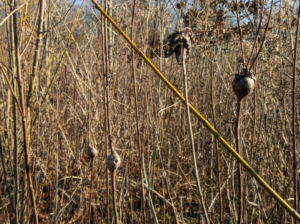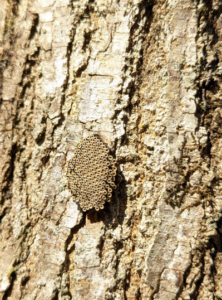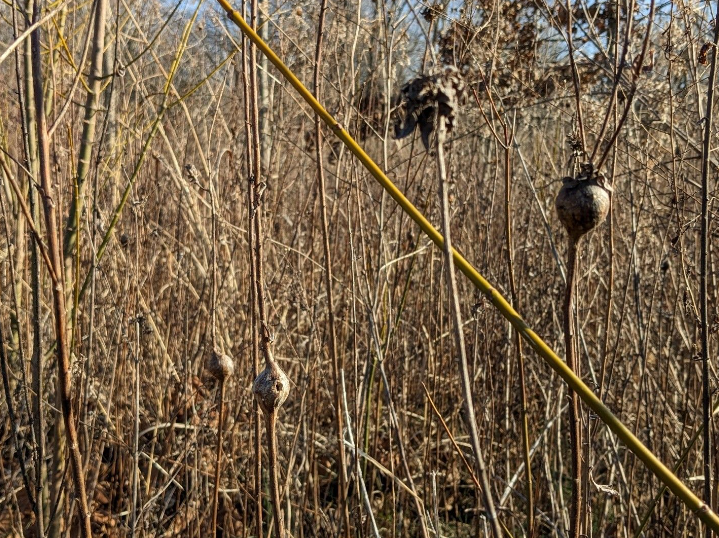Where Do All the Insects Go in Winter?
Writer / Erin Kinnetz, Education Specialist, The Parklands of Floyds Fork
Photography Provided
Spending time outdoors during the winter has its advantages. The bare trees allow you to really see the bones of the land. The shorter days give way to enjoyably cool, crisp weather. For bird watchers, the bare trees spotlight our resident birds. For some, an advantage might be a whole season of hiking and biking free from biting insects.
But where do all the insects go in winter? In Kentucky we have mild winters but animals in the wild still have two major concerns – the cold and less available food. Famously, our monarchs choose to leave the north behind, migrating to the Michoacán mountains of Mexico. This is a fascinating adaptation of the hardy, high-flying eastern monarch, but for most of our bugs, this would be an insane decision.
All our arthropods (hard-shelled creepy crawlies like insects, spiders, millipedes, crawdads and more) are ectothermic. You may have heard of this referred to as cold-blooded, although, bugs’ blood looks and moves differently than our own blood. Having to regulate your body temperature using your environment may seem like a detriment, but in fact it’s a great advantage.
When you are cold-blooded, your body can handle a wider range of temperatures and you need less food to do so. Even in Kentucky, most days in winter are still too cold for our bugs on land to move around easily. Instead, they go into a state of diapause, which is a kind of dormancy. Their bodies do as little as they can to stay alive. They don’t need to eat or drink, and they aren’t capable of movement. They can go into diapause at any stage of life including egg, larva, pupa or adult. If you were to stumble across one of these bugs in diapause, you might wonder if they were dead, but once the days get longer and warmer, they come out of diapause none the worse for wear. Some of our arthropods even have a special adaptation through which they fill their body with antifreeze proteins. This allows the arthropod to freeze solid and still live.
Going into diapause helps our bug friends survive the cold and low food availability, but it leaves them vulnerable to predation and drying out. A bug in diapause is an easy meal and can’t move out of the dry winter air. To prepare for their winter diapause, many bugs seek out or prepare a safe place to survive winter – a hibernaculum.
One bug home that I find delightful to try and spot is called a gall. This is a deformity on a plant part such as a leaf or stem. Many of these galls were induced to form by an insect such as a gall wasp or gall fly. This is usually part of a longer life strategy for which they get food from the plant in the previous summer. It also serves as a safe place to overwinter until they emerge as adults in the spring.
Insects aren’t known as deep thinkers, so they are happy to take advantage of obvious hiding spots such as under logs, mixed in among the plentiful leaf litter, in the crevasses of tree bark, and underground. While they may be obvious, they are very effective. I challenge you to find a silk moth cocoon wrapped in their leaf amongst the piles of leaf litter in our forests. If you were a hungry turkey, you could do it but you’d have to work at it.
If you are headed out on a winter bug hunt, a sure bet for finding some bugs is to flip over a log. If the day is warm enough, you may even see them moving around and going about their day as if it were spring and not winter. Our mild winters do make it easier on our arthropod friends to survive the winter and emerge once more in the spring.
In the Parklands, one important bug habitat is our stream, Floyds Fork. Interestingly, for our aquatic arthropods such a dragonfly larvae, mayfly larvae, and crayfish, the water isn’t too cold. It would be hard for us warm-blooded animals to imagine thinking the stream was comfortably warm in the winter, but for many of our ectothermic arthropods, the water feels fine. Remember, we said cold-blooded animals are more tolerant of a wider range of temperatures. Aquatic bugs need to be wary of the edges of the creek where the shallower water is more prone to freeze and hungry, clever predators such as mink may find them.
During summer, the edges of the creek are alive with activity, but for the winter, many of the cold-blooded bugs travel into deeper pools. The deeper pools act as a buffer keeping the temperature steady around 42 degrees. You can’t expect a warm day in the creek, but it also doesn’t get much colder than that. Aquatic bugs, like their terrestrial counterparts, can go through diapause, but they often don’t need to. Instead, they continue eating the decomposing leaf litter and other smaller bugs to get bigger for the next year. Sorry, this includes the much maligned but important mosquito larvae as well.
At this point you may be thinking about that deep freeze in December due to the polar vortex. I often heard the phrase, “At least we’ll have fewer bugs next year.” Fortunately, that’s not true for most of our arthropods! If our bugs are given the soils, leaf litter, logs, brush piles, streams and ponds they need, they can survive the mighty cold. It must be nice to be cold-blooded. Ticks do tend to choose more exposed overwintering spots and they’re often the first affected by extreme cold. They are good food for many of our animals and play a role in population control of some species. However, I do hate getting ticks, so I’m not too sad about losing a few ticks.
For a real impact on our bug population, we would need freezing temperatures in the -20 to -30 degree range for a sustained period – at least a couple of weeks. For Kentucky our winters are much easier than that, and luckily in the spring we can celebrate the return of the bugs as all the animals that depend on them for their food surely will. For now, enjoy the bug break during the winter.






